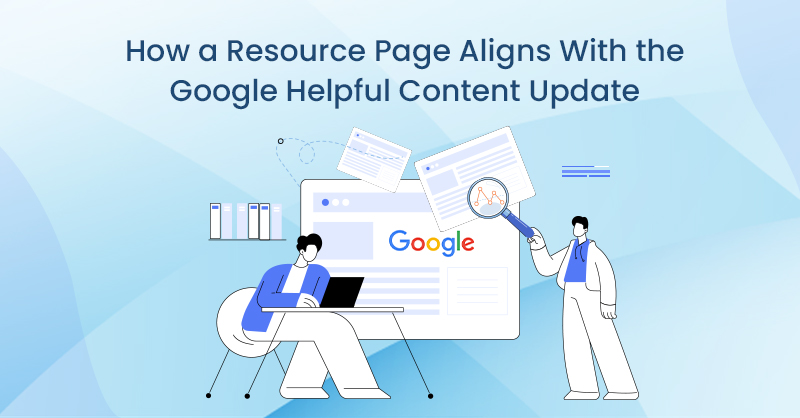It’s been a while since content marketing became an imperative. As time went by, brands were getting more and more creative with its shapes and sizes. Sadly, there are a lot of marketers who still get confused by different concepts of terminology floating around, let alone poor consumers who take native advertisement for typical articles.
While some content-related terms can be replaced by the others, marketers need to discern between sponsored content and native ads with confidence. There is a lot of misunderstanding that is still lingering around the term “sponsored content”. In this post, I want to go over some of the most typical misconceptions, share some ways of how to never get confused again, and how to start using this channel effectively.
Native Ads And Sponsored Content Are The Same
There’s a tendency to equate sponsored content with native ads. In reality, these paid activities have nothing in common.
It’s a known fact that consumers have become “blind” to ads, with Adblock usage surging 30% globally in 2016.
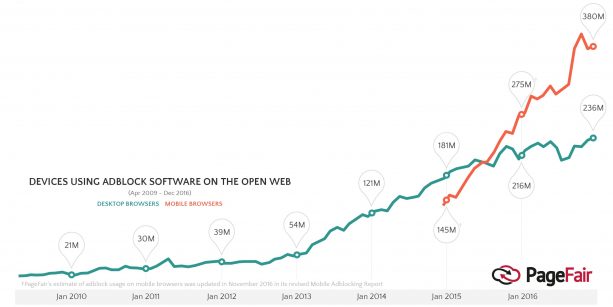
And as for motivation behind Adblock usage, one of the most cited reasons for that was "interruption" (29%), according to the same the report.
In some ways, native ads can be compared to display ads because they represent the new form of display advertising that users see as suggested posts which are similar to those they’ve read before.
But even blogs like SEJ use the terms interchangeably, but not always correctly:
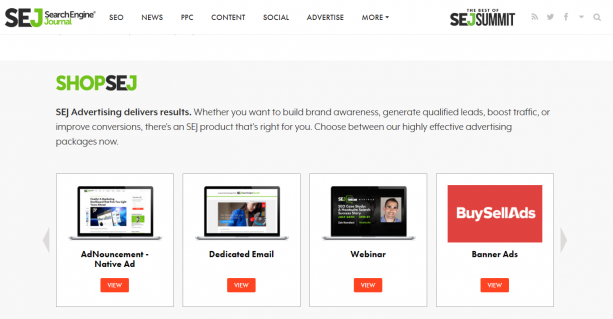
Native ads require content, but it’s not going to be content marketing because it’s straight up advertising. YouTube ads require content, too, but it’s also not going to be considered content marketing. In order to have an all-encompassing list of sites that feature native ads, marketers use platforms like Outbrain or Taboola.
Outbrain is the veteran of the market, it entered the industry in 2006. If you’re not familiar with this tool, it is a platform for content discovery where businesses can disseminate their content across big media giants like New York Post, CNN, Atlantic Media, ESPN, and many more. They also partner with smaller publishers. The way things work is pretty elementary: publishers get compensated depending on the amount of traffic they were able to redirect to the advertiser site. Using behavioral targeting technology, Outbrain increases user engagement and suggests online, video and mobile types of media.
In terms of functionality, Taboola is similar to Outbrain. It is a content marketing platform that offers a “scrolling news feed experience” users enjoy on social media to display promoted content. However, there is one feature that sets Outbrain apart from Taboola. It is the quality of the content that Outbrain meticulously filters according to their definition of spam. While Taboola’s content quality may not be so outstanding, the platform is constantly learning based on user’s feedback.
Among other platforms, there is Revcontent with its continuously growing network of users and several exclusive partnerships with companies like Newsweek and International Business Times under their belt. There’s also AdNow with its super easy registration process or Gravity with its big and promising statement of personalizing the entire web.
Paid Equals Poor Performance
Some people conclude that even a skillfully written content bearing a “sponsored” label will not perform as brilliantly as the non-sponsored content. According to a report by the Reuters Institute for the Study of Journalism, 43 percent of U.S. news consumers have felt deceived or let down by native advertising or sponsored content. By the same token, there’s no point in using ads on Google or any other channel because people learned to notice that such posts have been paid for. On the other hand, there are plenty of successful examples of ads out there that were delivered so gracefully, they ended up going viral and were distributed organically. It’s all about how you craft it, and what kind of story you’re telling people.
According to Meredith Levien, the executive vice president of advertising for The Times, NYT readers spend approximately the same amount of time reading advertiser-sponsored posts as they do news stories. A study by Sharethrough and IPG Media Labs confirms that statement (26 percent of sponsored content vs. 24 percent of editorial) and spend almost exactly the same amount of time on each (1-minute vs. 1.2 minutes).
As you can see, content performance doesn’t depend on whether or not it has "paid" tag on it. Besides, blogs that feature sponsored posts are extremely interested in building a long-term collaboration with your company. As a result, they’re going to extensively promote your paid post.
Here’s a great example of YouTube’s sponsored content that was distributed on Someecards.com - a website famous for its sarcastic old-fashioned style cards. YouTube delivered their own cards, and the most successful card was shared more than 35,000 times which exceeds the results of some of their most popular cards.
One thing you certainly shouldn’t forget about is promoting sponsored posts across your own channels. Some brands that purchase paid posts don’t really invest in any kind of promotion which is, frankly, very strange. If your company is being featured on a popular blog, you shouldn’t miss the opportunity and promote these posts using all of your channels! Sponsored posts strengthen your brand’s authority and can help you acquire more credibility in your industry.
Only Big Brands Invest In Sponsored Content
Surprisingly, many marketers firmly believe that sponsored content is something only big brands would be interested in. In their minds, big brands have already invested in all possible channels and are simply exploring new ways to spread the word. This myth is currently trending partially because some of the publishers take part in keeping it alive.
Blogs that provide sponsored content opportunities don’t really explain why one of them charges $500 per post while another is asking for $5,000, even if both blogs have the same amount of monthly traffic. In addition, the unspoken rule that exists on this market implies to hide all prices from potential buyers, and only reveal them after a user submits a request.
To help you maximize the effectiveness of this type of content, here are some valuable insights.
In some cases, a company can spend years on trying to organically get a column on one of the biggest sites in the industry. But sponsored content gets this company where it wants to be right here, right now.
Sponsored content is relevant to any company, no matter big or small. However, smaller companies have limited resources. In the majority of cases, they don’t feel convinced that buying a sponsored post can bring them traffic and sales. In reality, sponsored content can pay off tenfold and bring lots of leads and sales. But you need to keep in mind the following steps you need to take to make things happen:
- Find relevant and reliable sites by analyzing their current content performance
You need to keep an eye on both the number of users a site receives on a monthly basis and the fact that their users come from relevant sites. Another thing to check is what kind of traffic sources a site has. This information indicates how well a website promotes its content, and whether your sponsored post has any potential to show up on Google. This data can be found in SimilarWeb or in SEMrush Traffic Analytics, both tools give a good overview. However, SEMrush doesn’t offer any data about mobile usage, so for some industries, it might be a sensitive area.
- Get to know your industry rates
This seems to be one of the most complex tasks because websites that offer sponsored content opportunities aren’t willing to share their prices publicly. As a result, you have to send dozens of emails to collect this information. However, there’s a couple of sites that can give you your industry rates because they have already done this job for you. Among those sites is Prnews.io — a marketplace of sponsored content. This site will let you find a list of categories, prices, traffic sources, and some other interesting metrics that represent the overall site’s performance.
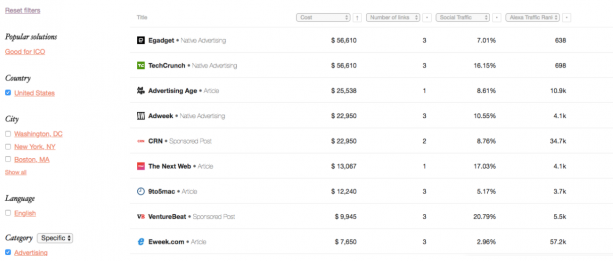
Optionally, you can use Pressboard.com, Playbuzz or any other tool listed in this post by Chad Pollitt. However, all of them ask you to contact them in order to learn about their database of sites and pricing. Another competitive advantage of PRnews.io is the simplicity of coordination. You won’t have to spend hours on finding emails, or craft messages with questions to feature your sponsored posts. All of that will be properly taken care of.
- Prepare excellent content that will contain a link to gated content through a registration form
Your content has to perfectly match the content of the site you want to get published on. I recommend using BuzzSumo that allows you to see the most viral posts a blog has, so it provides a good idea of what kind of content you need to prepare. For instance, here’s a list of the most viral posts on SEMrush blog:
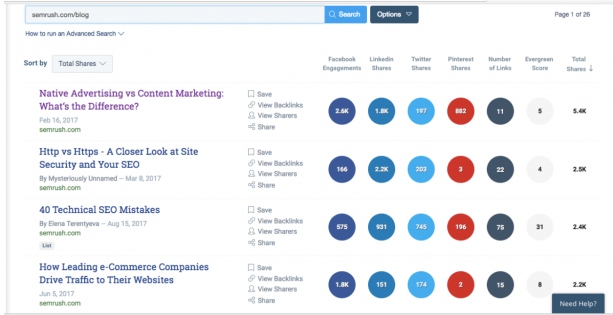
And the data proves that topics about native ads and technical SEO interest the online audience equally.
Once you create your post, you need to link it to the kind of material that will help you generate leads and get results from your future publication. For instance, if you decide to write about native ads, you can link it to a post that offers to download a list of native ads software with their pros and cons.
- Promote this content across your channels for a broader reach
Yes, sponsored posts should be promoted across your channels. They can help you improve your brand’s visibility and credibility. In some cases, sponsored posts can show your potential clients that you’re a trustworthy company they can rely on. Prepare some good looking visuals in advance to promote your post on Twitter, LinkedIn, and Facebook. I also highly recommend distributing your post to various Facebook and LinkedIn groups that are relevant to your business.
The Final Word
Sponsored content is thriving like never before. Unfortunately, data tips the scales against brands and publishers who have to work harder to win readers over by getting their attention, earning their trust and keeping content engaging.
Regardless of its numerous forms and sizes, content marketing has one specific purpose —to bring value, be useful, relevant, educational or entertaining to your audiences. If you created your sponsored post the right way, it will serve the same purpose.


